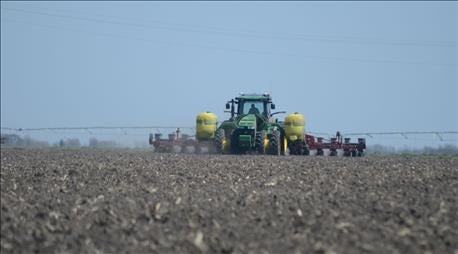
Dry field conditions? Check. Soil temperatures in the mid-to-upper 40's? Check. With abnormally dry, warm conditions this planting season, some corn growers in Nebraska wasted no time hitting the fields last week. That includes Jason Luebbe, Husker Harvest Days host farmer, who started planting Wednesday, April 13, when soil temperatures at the show site hit 48-49 degrees Fahrenheit.

READY TO ROLL: Host farmer Jason Luebbe began planting earlier this week on Wednesday, April 13. Conditions for planting have been ideal, but dry, windy weather and a lack of moisture is cause for concern from some growers moving forward.
Conditions for planting have been ideal, but the windy weather and lack of moisture is cause for concern from some growers. "We had this ground worked in the middle of March, and had some nice weather. In the last couple weeks, we've had wind, and more wind. The top three inches of soil is fairly dry. We have moisture underneath, but we're having a problem getting to it," said Luebbe. "Hopefully we get a rain. If we don't get a rain in a week or two, I may have to start irrigating."
As host farmer at the HHD show site, Luebbe has a front-row seat to test out all the latest and greatest technology. This year, in addition to the different population trials Luebbe conducts on a yearly basis, he's focusing on technology that will hopefully help improve return on investment. "New technology is one thing, but you still have to be cost-effective," he says. "The technology I moved toward this year is technology that will help us use fertilizer more efficiently."

FRONT-ROW SEAT: Luebbe has a front-row seat to see how different technology and management practices perform. This year, he's focusing on technology that will improve return on investment
Optimizing fertilizer efficiency
These new fertilizer tools include using double top saddle tanks made by Lake State Manufacturing, allowing Luebbe to have 125 gallons of an additional liquid fertilizer on each side without needing a front tank. In Luebbe's case, the double top tanks, along with the use of two pumps on his coulter and hiller allows him to dual-band and variable-rate thiosulfate with 32% nitrogen. It also includes several new fertilizer placement tools, like a 2x2 fertilizer tube from Schaffert Manufacturing to place fertilizer in the furrow and incorporate it into the soil to help minimize unnecessary loss of fertilizer.
For several years, Luebbe has used an AgXcel variable-rate fertilizer system to apply the right amount of fertilizer in the right place up front. This year, he's moving toward more application of nitrogen throughout the year. "We're doing a trial out here with chemigation through the pivots," he says. "We're going to do more spoon-feeding throughout the year. This way, with tighter margins, we can see if we can spoon feed and cut fertility costs back a little bit."
With tighter margins, Luebbe notes it's crucial to evaluate every dollar invested per bushel returned. So, once the corn emerges, stand counts will be conducted, and Luebbe is paying close attention to uniformity of emergence. "If we get good weather and we think we're going to have optimal yields, we'd shoot for a bigger yield. If the crop emerges uneven, non-uniformly, we might look at cutting back a bit on our yield goal," he says. "Every dollar per acre you can save in times like this is very helpful."
About the Author(s)
You May Also Like






